Keyword difficulty is a crucial element of keyword research. Get it right and you can start ranking quickly.
But skip over keyword difficulty, and you’ll likely waste resources creating content that never ranks.
In this article, we’ll explain keyword difficulty and show you how to use it to make your content strategy successful.
In This Article
What is Keyword Difficulty?
Keyword difficulty is a metric that indicates how hard it is to rank on the first page (top 10) of Google Search results for a given keyword.
Available in keyword research software, the keyword difficulty metric is measured on a logarithmic scale out of 100, with 100 being the most difficult to rank for.
Because these scores are calculated on a logarithmic scale, they’re often displayed with descriptors like “Easy,” “Possible,” “Moderate,” or “Hard.”
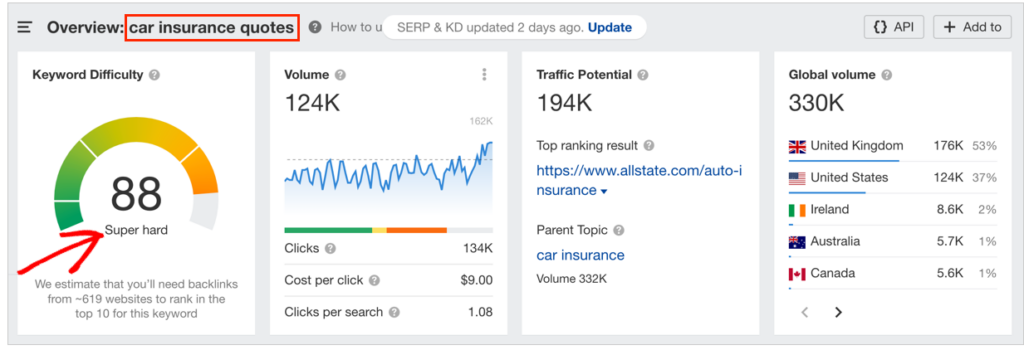
The keyword difficulty score will often be displayed with the estimated number of backlinks you’ll need to rank in the top 10.
These scores assume that the content you create will be high-quality. Plan to create an article that’s better than what’s in the top 10 and meets search intent.
How are Keyword Difficulty Scores Measured?
Keyword difficulty scores are created with proprietary methods. These scores typically factor in the number of backlinks to top-ranking pages and the domain authority or page authority score for those pages.
Here it’s worth noting that Google Search doesn’t generate keyword difficulty scores. These scores are an attempt by software companies to crack part of Google’s “black box” and make content production more efficient.
After all, no one wants to compete in a race they can’t win.
And that brings us to the importance of keyword difficulty.
Why is Keyword Difficulty Important?
To create content that ranks and drives conversions, you must make keyword difficulty checks a routine part of your content strategy.
Otherwise, you’ll waste resources and lose market share to your competitors.
Keyword difficulty scores will tell you whether a keyword is winnable and how stiff the competition is.
For instance, imagine you just launched a new blog. The keywords you’re researching are all rated “hard” or “very hard.” The top-ranking articles for those keywords are from big brands like The Wall St. Journal and the University of Oxford.
You have no reasonable chance of ranking for those keywords. Instead of wasting time and resources trying, you can focus on keywords with an “easy” or “possible” rating.
Choosing winnable keywords to create content on will lead to steady traffic growth.
And this is where long-tail keywords come in.
Long-Tail Keywords and Conversions
Long-tail keywords are detailed search phrases. The opposite of a long-tail keyword is a broad topic (also called a short-tail keyword).
To understand these keywords better, imagine you have a home improvement business that provides flooring installation and repair services.
You might research keywords like “flooring” and “home flooring,” but these are rated “Very hard” to rank for.
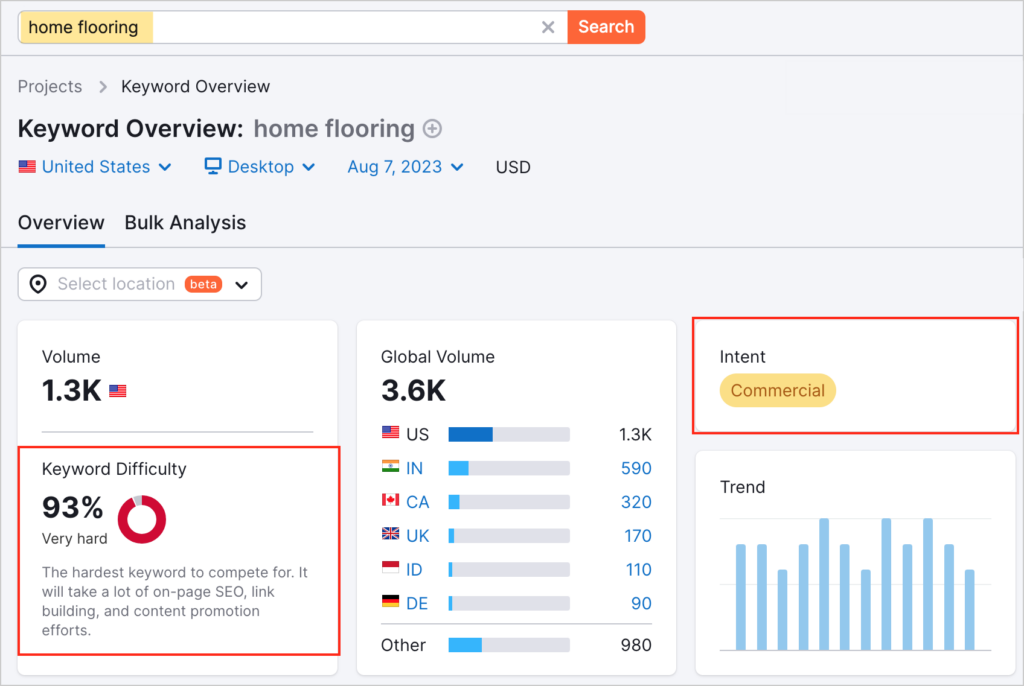
Broad topics, also called “short-tail keywords,” are often difficult to rank for.
However, the following long-tail keywords are rated “Easy” to rank for:
- “what is a floating floor”
- “floating floor samples”
- “5 inch maple hardwood flooring”
There are countless numbers of these easy key phrases.
Keywords Reflect Search Intent
To pick good keywords, it’s best to consider search intent along with the keyword difficulty score.
Search intent is designated in Semrush by letters:
- I is for Informational: The searcher is gathering information and often has no buying intent yet.
- N is for Navigational: the intent is to find a particular product or website (e.g., “in-and-out burger”)
- C is for Commercial: the searcher typically compares and considers products, often with a goal of buying in the near term. These searchers may also be trying to solve a problem and might be searching for “How to” content.
- T is for Transactional: the searcher is on the brink of buying.
An ideal content strategy will focus on long-tail keywords with a low difficulty score and commercial or transactional intent.
It’s likely you’ll also need to create some informational content too. Just be careful not to ignore keywords with commercial and transactional intent. Remember, content focused on the latter will attract people with buying intent.
Next, we’ll show you how to check keyword difficulty and find keywords worth ranking for.
How to Check Keyword Difficulty
For our tutorial, we’ll be using Semrush, a popular keyword research tool.
Step 1: Create a Semrush account
First, create a Semrush account. You can sign up for a 7-day free trial and cancel anytime.
Step 2: Enter a Keyword into Keyword Overview
Next, open Semrush and click Keyword Overview in the left-hand column. In the blank field, enter a keyword you want to research. For our example, we’ll enter “floating floor.”
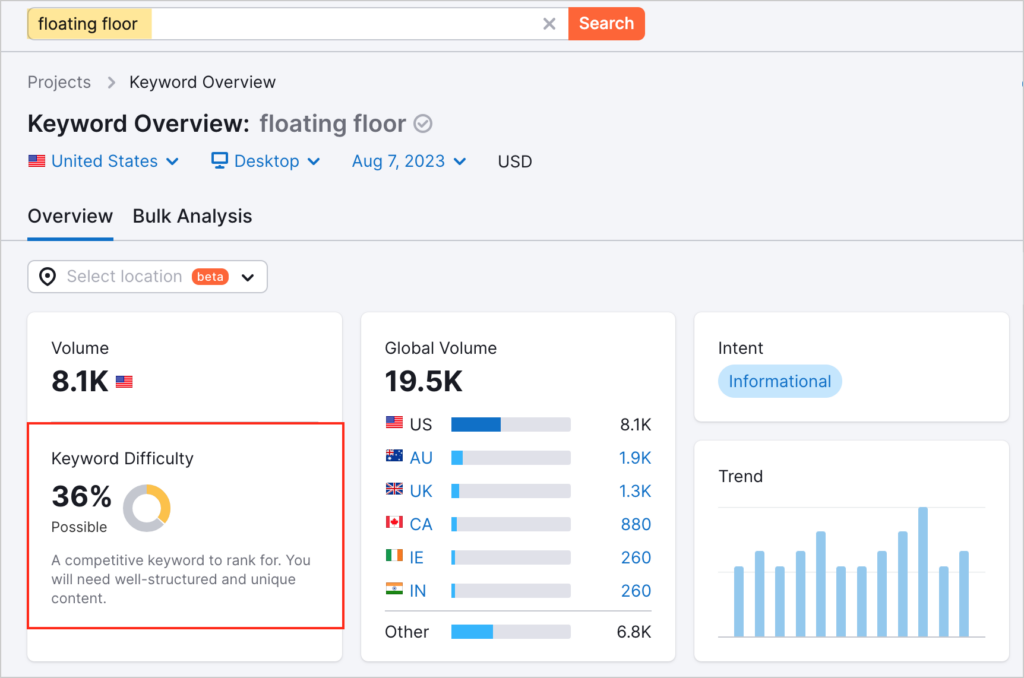
The keyword has a difficulty score of 36% which is described as “Possible.” Beneath the score, Semrush provides some helpful context. “A competitive keyword to rank for. You will need well-structured and unique content.”
At right we see the intent is “Informational.” We decide to create informational content on the topic of “floating floors” but we want to find some long-tail keywords with Commercial and Transactional intent. How do we do that?
Step 3: Find Long-Tail Keywords with Commercial or Transactional Intent
Simply click the Keyword Magic Tool at left in the navigation column. Now we have over 9,000 long-tail keywords related to “floating floor.”

We can sort these results by clicking the KD% (Keyword Difficulty score) column twice. (Clicking it once will sort it by highest KD down.)
We see the following keywords are easy to rank for and have Commercial or Transactional intent:
- sound tec floating floor
- wide plank floating floor
- walnut floating floor
- best floating floors
- glue down vinyl plank flooring vs floating
- floating floor vs glue down
- floating floors pros and cons
- floating kitchen floor
- vapor barrier for floating floor
- pine floating floor
- floating cork floor tiles
- solid wood floating floor
- floating floor clearance
- and so on.
Your next step would be to sort through the results and pick a handful of topics to create content on.
Understanding Search Volume
Notice that Semrush provides an estimated monthly search volume number, too. This is the estimated amount of monthly searches for a keyword. You’ll see a number for the U.S. and one for “Global.”
It’s not uncommon to see N/A (not available) for search volume. This means Semrush doesn’t have enough clickstream data to provide an estimation.
Realize that you can also choose to search by U.S. state or city. Again, the search volume will be an estimation only.
Many marketers recommend finding high-volume, low-competition keywords. That’s a good approach, but it’s worth remembering that search intent is key, and traffic doesn’t equal revenue. So you could rank high for many informational keywords with “easy” KD scores and wind up with traffic that doesn’t convert.
Conversely, you could rank for commercial and transactional keywords with lower volume and grow revenue consistently.
Now, after choosing long-tail keywords and creating quality content on them, there’s one more step to rank well.
Optimize Your Content for SEO
Once you’ve created your content, you’ll need to optimize it for search engines. This is where a plugin like All in One SEO (AIOSEO) comes in.
With thousands of 5-star reviews, AIOSEO is a proven solution for on-page search engine optimization.
The easy-to-use features let you optimize titles, meta descriptions, schemas, and more.

Ranking high in search results is easier with AIOSEO. The plugin analyzes your content and gives actionable suggestions to boost SEO. In just 5 minutes, we can implement the recommendations and increase our pages’ optimization score.
We use AIOSEO on every article before publishing. It’s been instrumental in growing our revenue and sales through improved search visibility.
With one click, AIOSEO can add rich snippets to better highlight your content in search engine results pages (SERPs).

Readability checks also ensure your pages are readable and engaging.
AIOSEO’s user-friendly design makes on-page optimization simple, even for beginners.
By following AIOSEO’s specific SEO tips, you can rank higher and reach more of your target audience.
We rely on this powerful plugin to improve search rankings for all our website content.
See the SEO Impact of Your Changes
AIOSEO is unique because it shows you how your edits impact your search engine rankings.
This new feature is called SEO Revisions. And All in One SEO (AIOSEO) is the only plugin that offers it.
You’ll also see when Google releases new algorithm updates and how those impact your content.
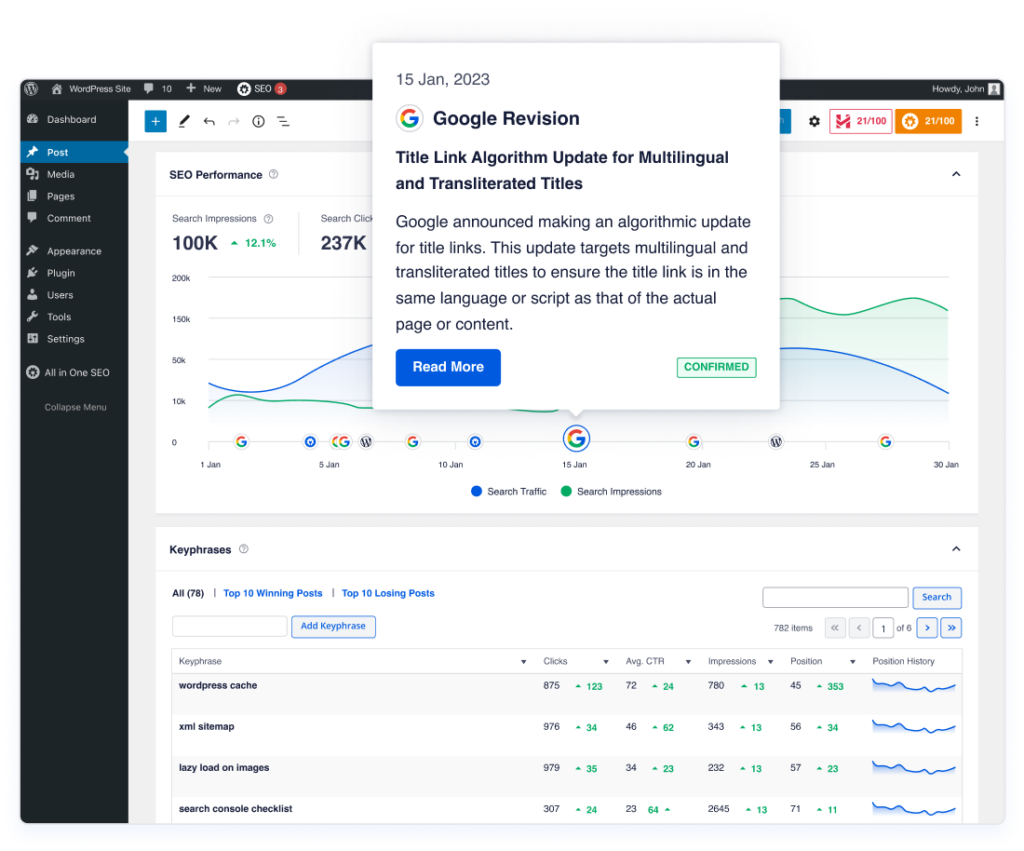
Q&A on Keyword Difficulty
Is high keyword difficulty good?
The higher the keyword difficulty score, the harder it will be for a new article to rank in the top 10 Google search results. The most cost-effective approach to content creation is to target low-difficulty keywords that are relevant to your niche and have a decent search volume.
Which SEO tool is best for discovering keyword difficulty?
There are many reliable SEO tools that provide keyword difficulty scores, including Ahrefs, Semrush, and Ubersuggest. These keyword research tools have many of the same features, so the “best” one may be the one whose interface you like the most and the one that fits your budget.
Resources for Keyword Research
- How to Track SEO Keyword Rankings in WordPress
- How to Easily Monitor SEO Rankings in WordPress
- How to Use SEO Data to Boost Your Search Rankings
- Best Keyword Analysis Tools
- How to Steal Your Competitors Top Keywords
- How to Find Long-Tail Keywords and Increase Organic Traffic
- 7 SEO Secrets Used By the Pros to Grow Revenue
- TOFU, MOFU, BOFU in SEO: How to Drive Revenue the Smart Way
What’s Next
Now that you’ve learned what keyword difficulty is and why it’s important what’s next? Explore How long does it take to get SEO results? And don’t forget to plan for conversions.
Join us on our YouTube Channel for easy-to-follow WordPress SEO tutorials. You can also follow us on X (Twitter), LinkedIn, or Facebook to stay in the loop.
Disclosure: Our content is reader-supported. This means if you click on some of our links, then we may earn a commission. We only recommend products that we believe will add value to our readers.
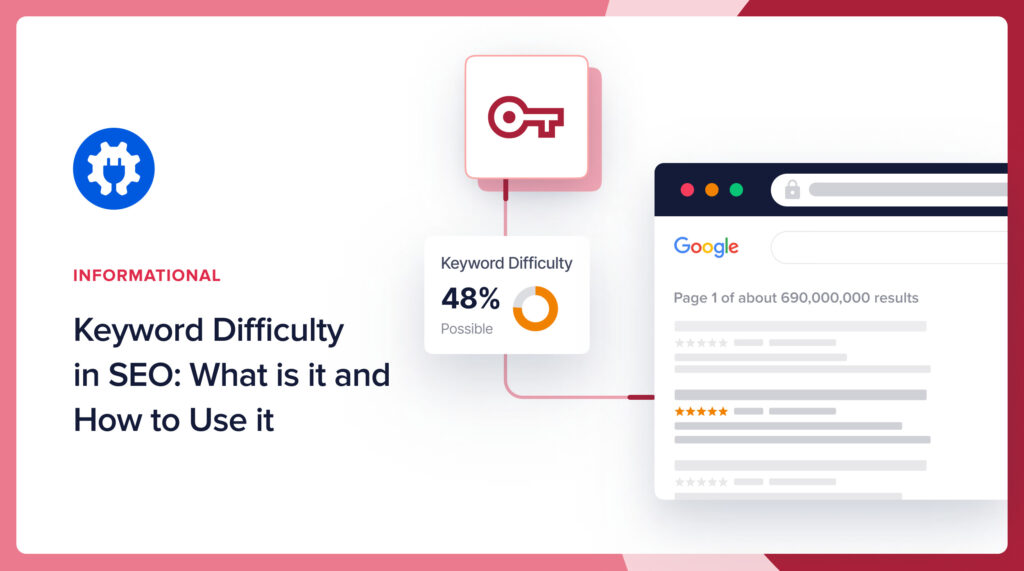

This is a great article- I am truly enjoying using AIOSEO- it has made my site actually a blip on the screen and growing.
Hi Steven – Thank you for your kind feedback. Delighted to hear you found the article useful and that AIOSEO is raising the profile of your site!
Thank you, a very useful article. I will be happy to use your plugin. I think this is the best solution for optimization.
Hi Валентин – Thank you for your thoughtful feedback. Glad to hear the article is useful for you. And thank you for your kind words about the plugin.